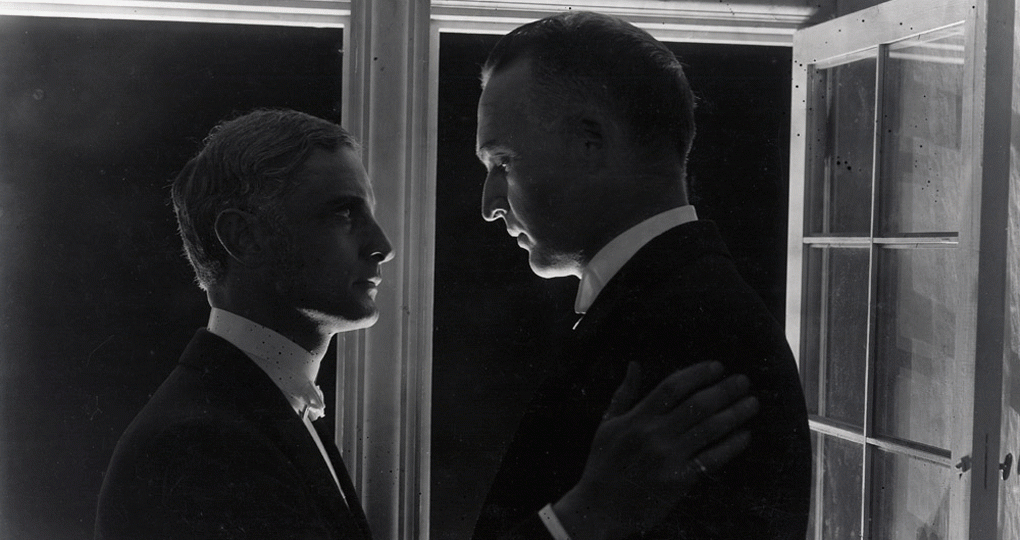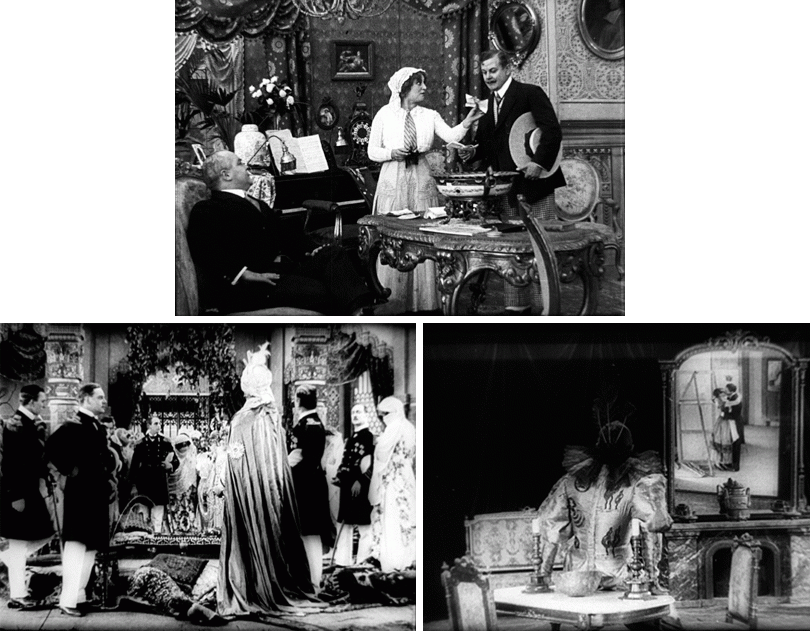
It’s a remarkable fact of film history that the years from 1911 to 1920 gave us our first canon of masters. True, some of the great names (Griffith, Feuillade, Perret) began directing slightly before this. Nonetheless, the blossoming of classic silent cinema began with the emergence of Sjöström, Stiller, af Klercker, Christensen, Ford, De Mille, Stroheim, Dwan, Curtiz, Murnau, Lang, Chaplin, Hofer, Wiene, Dulac, Gance, Delluc, L’Herbier, Dupont, Lubitsch, Feyder, Raoul Walsh, Maurice Tourneur . . . and Carl Theodor Dreyer. All made their first films in a decade that now looks like the beginning of cinema as a mature art form.
Film as mass entertainment
Circumstances proved favorable. During this decade filmmaking became the mass entertainment industry we know today. The major European film companies, though declining during World War I, still fostered innovative work. American cinema established its studio system and gained domination of world markets. The star system emerged, along with the multi-reel feature film.
Film screenings, which had been brief and casual diversions, became well-organized spectacles consisting of full programs playing in well-appointed theatres. Along with these developments came the specialized trade press, film magazines, and movie merchandising—a film culture that remains with us today. Not least, there emerged a standardized approach to cinematic style, a way of presenting a story to maximize clarity and emotional power.
Youth matters!
The growth of film industries throughout the world at this period expanded job opportunities in all crafts. Some directors began relatively late in life; John Emerson directed his first film at forty-one, Andre Antoine at fifty-eight. But most of the creative talents entering the industry were young, men and women in their mid-twenties through early thirties. Throughout cinema history, youth matters.1
We seldom think of directors in relation to age cohorts. Granted, we now speak of the film-school or movie-brats generation of the 1970s, and we sometimes consider today’s US independent filmmakers as part of the Net or DIY generation. Thinking this way is evidently more common in Asia: the Chinese have categorized directors as members of numbered generations, and the Korean directors who made their breakthroughs in the 1990s and 2000s were considered part of the 386 generation—named after a computer chip and signaling their affinities with the digital revolution.2
Still, we’re not generally accustomed to thinking about classic European or American film history in generational terms. The directors we admire tend to be cut off from their cohorts. Both Michael Curtiz and Anthony Mann were making films in the 1940s, but we seldom note that they were born twenty years apart. Often such things don’t matter. Yet at times, I think, generation-based explanations are helpful.
1910s: Surprising synchronizations
Once we look at the 1910s, we find some surprising synchronizations. Curtiz and Murnau were born in 1888; Lang, Delluc, and L’Herbier were born in 1890. Gance, Chaplin, and Dreyer were exact contemporaries, all born in 1889. I’m not casting runes here. My point is that many directors debuting in the 1910s were young enough to have a fresh perspective on this new medium. They were the first “movie generation,” with films forming part of their childhood and adolescent experience. As they came to maturity they saw cinema transformed into a popular narrative medium, sustained by lengthy fictional stories. Older filmmakers, like Griffith, Feuillade and Perret, had helped create this transformation, but in doing so they established their preferred routines of production and expression. The youngsters had somewhat different creative opportunities and choices.
The tableau style and continuity filmmaking
Elsewhere I’ve argued that during the 1910s two broad styles were in play. There was a tableau style based in elaborate performance and staging in the single shot, while an editing-driven style relied on close views, scene breakdown, and crosscutting. During the 1910s the tableau approach, largely identified with European cinema, gave way to the editing-based one, spearheaded by US filmmakers. By the early 1920s, “continuity” filmmaking, as the Americans called it, was the default approach in most filmmaking countries.
It seems to me that most directors who started before the 1910s (essentially in the mid-1900s) devoted themselves to refining the tableau tradition. The results were rewarding, but older filmmakers were slow to assimilate the new methods of the Americans. By contrast, the younger generation could look at the editing-based cinema of Hollywood with fresh eyes.
Of course this account is a bit too neat. In my period layout, Griffith is notoriously in-between, launching his career in 1908 and quickly pioneered his own variants of the new methods. There were national time-lags as well. Some filmmakers picked up American methods quite quickly, perhaps because they had had access to Hollywood films fairly early. The crucial murder scene of Gance’s Mater Dolorosa (1917) is a tour de force of analytical editing that rivals anything then coming out of Hollywood. Sjöström is perhaps the model of the fast learner, having created one of the masterpieces of tableau cinema in Ingeborg Holm (1913) and only a few years later making The Girl from Stormycroft (1917) and The Outlaw and His Wife (1918), assured exercises in continuity editing. German filmmakers were somewhat slower to adopt the continuity style, perhaps because US films of the crucial years 1916-1920 were denied them by a ban until 1921.3 Nonetheless, Lang’s Die Spinnen (1919) shows strong traces of US influence, especially in a barroom gunfight that could have come from a William S. Hart western. (Perhaps Lang grasped continuity principles based on pre-1916 releases and extrapolated them.) When American films were available from 1921 onward, German directors adopted American methods swiftly.
In only a few years, the new style came to ascendance. Just as young people in the 1990s adapted to digital culture faster than their elders did, I hypothesize, the twentysomethings and early thirtysomethings of the 1910s sensed the new style as cutting-edge and were able to master it quickly. By the early 1920s, most feature films in Europe were made in the American mold.
The learning curve in Denmark
What was the learning curve like in Denmark? The studios had fostered outstanding instances of the tableau style from at least Afgrunden (1910) onward, and the Danish cinema had few peers in the subtlety of its acting, lighting, set design, and intricate staging.4 American films were screened in the country, but not until 1916 or so, it seems, did they achieve popularity.5 And on the basis of viewing several of the surviving films from the period, I suspect that the older Danish directors were not eager to change methods. They adhered to a staging-driven model. True, they did resort to crosscutting, although at a slower pace than the Americans. And they employed axial cutting (that is, cutting straight in and back along the camera axis) to stress a dramatic high point. But occasional axial cutting was common in European cinema generally at this period. It seems to have been conservative directors’ main concession to the editing aesthetic.
Dreyer’s debut: The President
In Denmark Dreyer counted as a youngster. Virtually all the established directors were born in the 1860s and 1870s, and most had learned their craft in the 00’s and early 10’s. Eduard Schnedler-Sorensen, who was just three years older than Dreyer, had begun directing in 1909. (Only A. W. Sandberg was close to Dreyer’s age, and he started his directing career in 1914.) Although there was a steady exodus of directing talent from Nordisk, the shrinking of the international market and some miscalculations in the company’s business strategies didn’t lead to new opportunities for beginners.6In 1918, no Danish feature film was signed by a first-timer.7 In the following year, only a single release came from a debut director; that was The President (Præsidenten), by Dreyer.
Apart from writing scripts for Nordisk, Dreyer participated in editing the films that flowed out of Nordisk. Perhaps this task attuned him to the new methods on display in the American imports. In any case, by 1918, when he was just shy of thirty, he had evidently absorbed the logic of the American continuity system. He proceeded to make a film whose assurance in handling space through editing makes its local contemporaries look old-fashioned. The President is also rather exploratory in that it offers glimpses of a characteristic Dreyerian approach to cinematic space, one that reworks the emerging continuity system. Though we don’t think of Dreyer as a young Turk, The President seems, in the context of Danish cinema of its moment, a notable experiment in a style that was just achieving international stature.
Dreyer’s editing strategies
The President immediately commands attention for its painterly imagery. Its décor, highlighting bare walls or a geometrical layout of pictures and cameos, and its remarkable range of lighting, especially its night effects, have been justly praised. Similarly celebrated is its way with distinctive faces, most notably those of bit players. I want here to concentrate on another aspect: the extent to which Dreyer’s editing strategies “update” Danish filmmaking along American lines.
By this, I don’t just mean the film’s vigorous crosscutting. Certainly the climax of The President, with its suspensefully intercut strands of action (ceremonial banquet, torchlight procession, prison escape) is well-wrought. But you can argue that it simply pushes further some tendencies already emerging at Nordisk in films like A Trip to Mars (Himmelskibet, 1918). What shows Dreyer’s innovations more starkly, I think, is his handling of protracted scenes played out in interiors.
What Dreyer doesn’t do
We can start by noting what he doesn’t do. During the 1910s while Hollywood was simplifying its set design and making backgrounds unobtrusive, most prestigious European films packed their sets—especially the parlors, boudoirs, and ballrooms of upper-class life.8 In Denmark and elsewhere, the actors thread their way through a tangle of furniture, props, and decorations (A Modern Girl/ Vor Tids Dame, 1912).
These stuffed, expansive sets create a relatively deep playing space. Danish directors built up a tradition of virtuoso depth staging, often amplified by windows, doorways, and props, particularly mirrors (A Prince of Bharata / Maharadjahens Yndlingshustru, 1917; The Clown/ Klovnen 1916).

Even commonplace scenes in parlors set up a sturdy foreground with a table or desk and let action play out in planes behind that (The Woman Tempted Me/ Den frelsende Film, 1916).
Of course not all 1910s Danish films exploit depth in interiors extensively. Many scenes simply spread the actors out across a single plane in the middle ground, a sort of default clothesline arrangement (A Revolutionary Wedding/ Revolutionsbryllup, 1915).
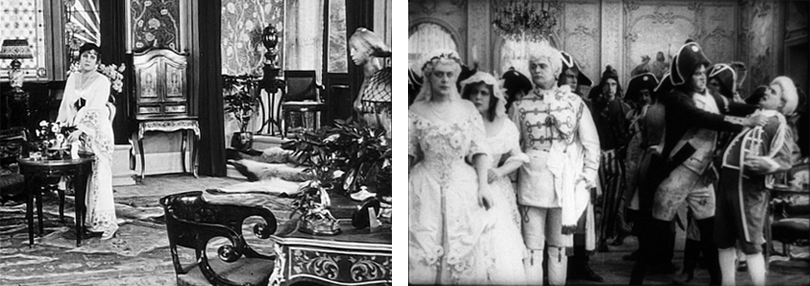
Scenes taking place in deep sets may include axial cuts, often ones that preserve depth even in a closer view. This sort of compromise style, in which lateral staging rules but is punctuated by occasional glimpses of depth, hung on for some time, as in Holger-Madsen’s Towards the Light (Mod Lyset, 1919).
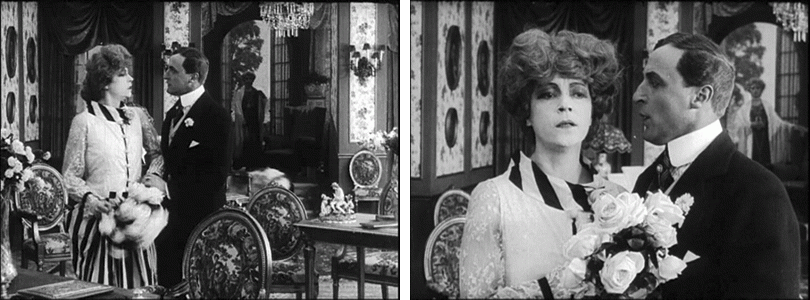
The horizontal scene in The President
The President tries something bolder. Dreyer almost completely negates the dense, deep compositions that ruled Danish film. His parlors are uncluttered, almost stark. Compare his use of paintings and cameos with the jammed deep space in Sister Cecilia (Hvor Sorgerne glemmes, 1915).
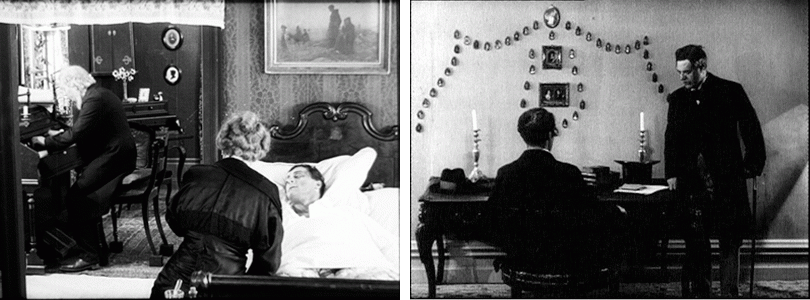
Dreyer’s long shots shove the furniture up against the back wall and open up a gaping area between the camera and the players. The shot looks oddly anachronistic, almost as if Dreyer had reverted to the “primitive, theatrical” space of Méliès and his contemporaries at the turn of the century. Likewise, Karl Victor’s study is virtually the inverse of tableau space.
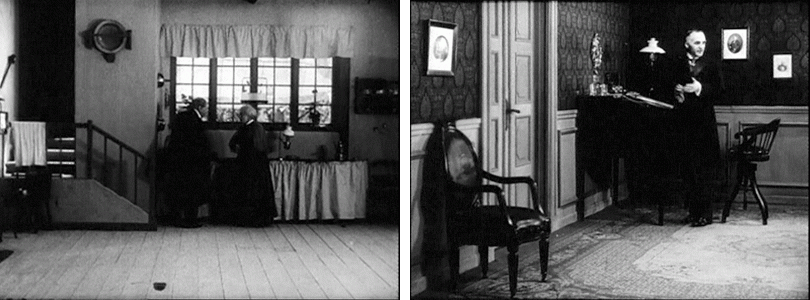
The desk, a mere escritoire rather than the massive one we might expect in a film of the period, sits flush with a side wall, not looming in the foreground. Instead of the inevitable doorway in the rear, there is only another wall. Nothing pulls the actors to the foreground; the scene must play out horizontally.
The emptying out of the playing space can be seen vividly in the courtroom scene. A few years before, Hjalmar Davidsen played a climactic trial in ripe tableau depth for Alone with the Devil (Ekspressens Mysterium, 1914). But Dreyer stretches out the areas in a mild fan shape, so that the camera must pan leftward to show the court audience, the prosecution, the magistrates, and the defense table.
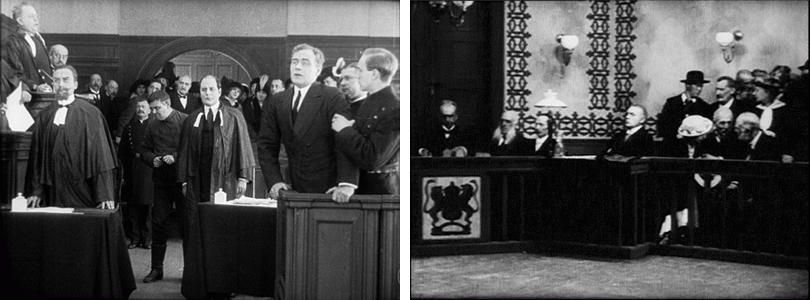
The distant framings of Karl Victor’s study and the jury room turn out to operate as establishing shots in the American mold. The scene will not be based on intricate choreography, with actors stalking to and from the foreground and shifting position in order to block or reveal scenic elements. In Victorine’s trial, the courtroom space is broken up into forty-one shots (not counting the shots in the embedded flashback or the cutaways to other locales). There is only one axial cut-in. Otherwise, the camera positions are varied in angle and scale, yielding group shots, two-shots, singles, and fairly intense close-ups.
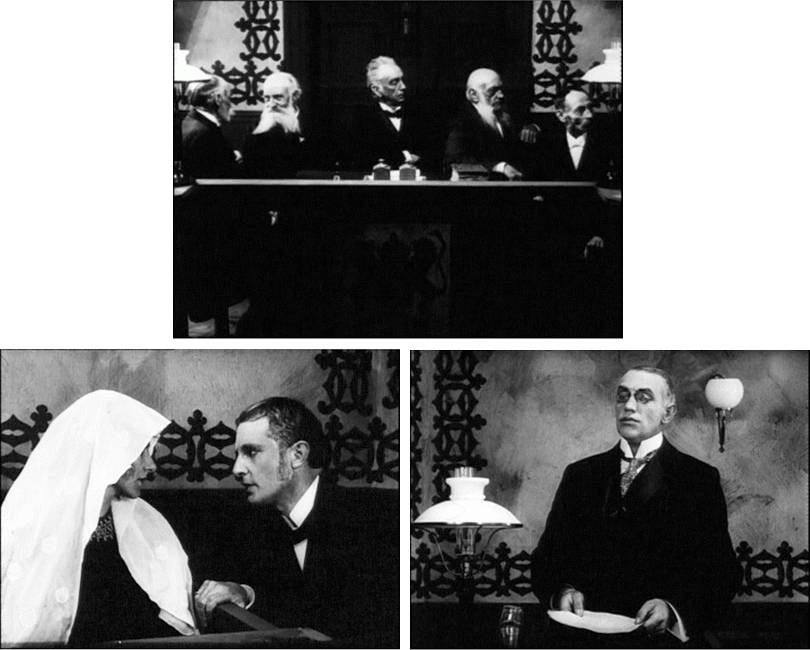
Victorine’s reactions, the crux of the drama, are rendered in no fewer than eight distinctly different camera setups. Here is a sampling.
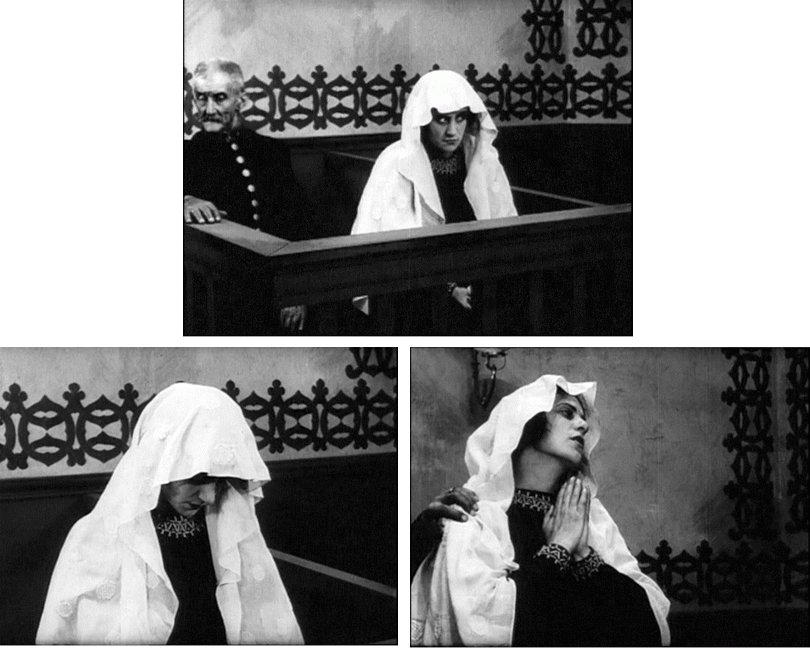
Moreover, each of these camera setups is calibrated to the size of the action it must contain. The early framing on Victorine and her guard allows Dreyer to give the guard a bit of homely realism by brushing dust from his sleeve after she has lowered her head. In later shots, the guard is clipped out of the frame, except when he is necessary to restrain her outburst or lead her from the courtroom. The deliberate off-center framing of her beseeching gesture is given extra poignancy by his restraining hand on frame left.
Now we see that, as in the American cinema, the stripped-down backgrounds benefit a style depending on close views. Blank or simply decorated walls throw faces into relief. Dreyer’s concession to the decorative side of Danish film is the creation of simple, almost abstract patterns on the walls—which in a way only heighten the sense of a stripped-down setting.
Where to put the dialogue titles
Consider another nuance, one that is seldom mentioned in discussions of silent film. Throughout film history, every stylistic innovation brings along a cluster of new choices. By breaking a scene into a series of single shots of characters, continuity-oriented directors were confronted with the problem of how to integrate dialogue titles. They settled on a fairly redundant solution. Given separate shots of speaker and listener in a conversation, silent-film directors tended to sandwich the dialogue title between two shots of the speaker. So: speaker/ title/ speaker. But American filmmakers sometimes picked up the pace by deleting the second shot of the speaker, cutting directly from the dialogue line to the listener’s reaction. The result is a pattern of speaker/ title/ listener. This produces an abrupt dramatic beat.
During most of The President, dialogue titles interrupt full shots encasing both speaker and listener. But often Dreyer introduces the speaker/ title/ listener pattern for moments of heightened emphasis. The result is most sustained in the trial scene.
The first dialogue title, an announcement from Vice-President Werner, is enclosed within shots of the judges. But when the prosecutor begins his case by announcing that Victorine was obviously “corrupted at an early age,” an angry close-up of her follows immediately. He goes on to call her mother a woman of easy virtue, and again we get an instant reaction shot as she rises to cry that he’s lying. And her dialogue title is followed by a reaction shot of the audience wagging their heads at her impudence. For the courtroom action that follows, Dreyer employs seven instances of the more orthodox pattern of speaker/ title/ speaker. Only when the judges reassemble to read their verdict of death does Dreyer cut directly from that intertitle to Victorine’s expression of almost serene acceptance.
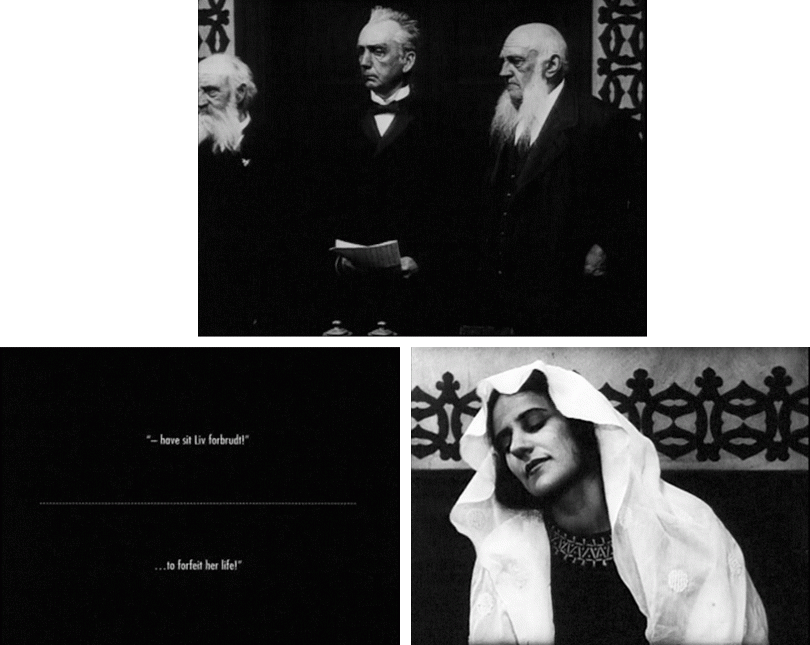
Clearly Dreyer has understood that deleting the follow-up shot of the speaker can subtly accelerate the dramatic rhythm.9
Dreyer’s nuanced editing
This trial scene may look rudimentary to us today, and American films of the time can boast a comparable variety of editing devices. Yet no other films I’ve examined from Denmark in the 1910s, including several from late in the decade, display such nuanced editing within a single locale.
It’s true that in the 1910s, scenes in courtrooms are often broken into many shots, largely because it’s hard to show the entire scene in a single framing. And no other scene in The President is sustained so long through analytical cutting. But different scenes illustrate the same principles. Dreyer routinely breaks his interiors into adjacent zones, sometimes without benefit of an establishing shot. Edvin Kau has called attention to the remarkable moment early in the film in which Maika confronts von Sendlingen in his study and Franz Victor enters to them.10 It is a rapid-fire passage shifting among oblique long-shots and medium-shots, spiked by a sudden close-up of a door handle—motivated, in the American manner, by a shot showing Maika and the old man turning as they hear the door open.
Another instance occurs soon after, in the forced wedding of Franz Victor and Maika. The scene is given as a master shot followed by several inserted close-ups from various positions.
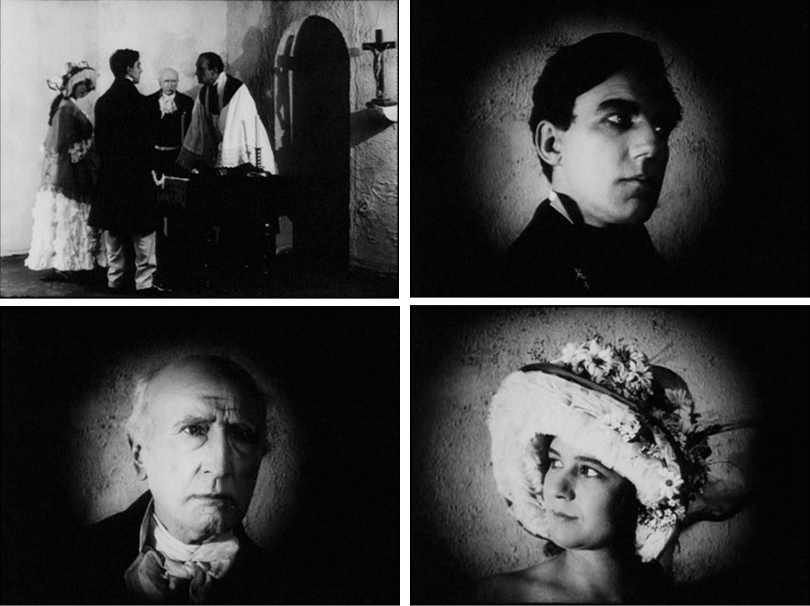
Such experiments in fragmentation might be taken as one-off flourishes; I’m not sure that the big close-up of the doorknob warrants such emphasis. But the marriage scene does find its mate later, when another wedding is played in a comparable suite of close-ups.

What lies offscreen
In the tableau style, an interior scene’s playing space tends to stretch out luxuriantly from the camera’s lens. What then lies offscreen? Well, chiefly the areas to the left or right of what we see: adjacent rooms, a garden or terrace, a hallway. In rare cases, the director may invoke the space “behind” the camera, cutting 180 degrees to reveal another area stretching into the distance, such as the rest of the room or another wall with another door. A good example of this tactic occurs in Holger-Madsen’s A Friend of the People (Folkets Ven, 1918). Normally, however, everything we should see is spread out in front of us and we need never worry about what lies behind the camera.
In his sound films, Dreyer became fascinated with camera movement that wheels around interiors, apparently following the characters along a horizontal path but actually revealing three or even four walls of the rooms they inhabited. His gentle traveling shots flatten cubical space into a ribbon. Some of his silent films invoke this 360-degree playing space, but they present it through editing rather than camera movement. That process is thoroughly developed in Michael (1924) and Master of the House (Du Skal Aere din Hustru, 1925), but we can glimpse it as well in The President.
Karl Victor and his friend, the lawyer Berger, are visited by the vice-president Werner, who asks Karl Victor to preside over Victorine’s hearing. Werner’s entrance activates an offscreen area by the doorway in an unusual way. The two men look up, and Werner nods at them before walking diagonally off left.
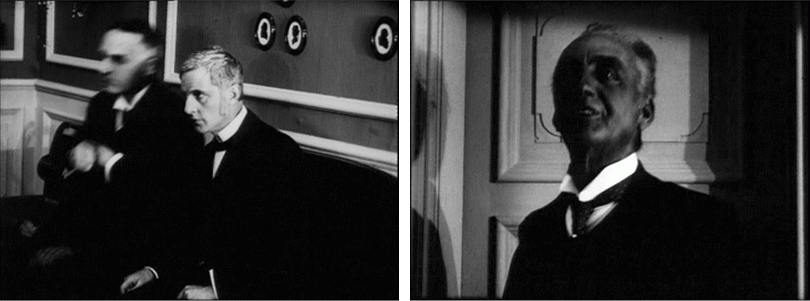
He enters sharply from screen right and speaks with Karl Victor, who listens intently.
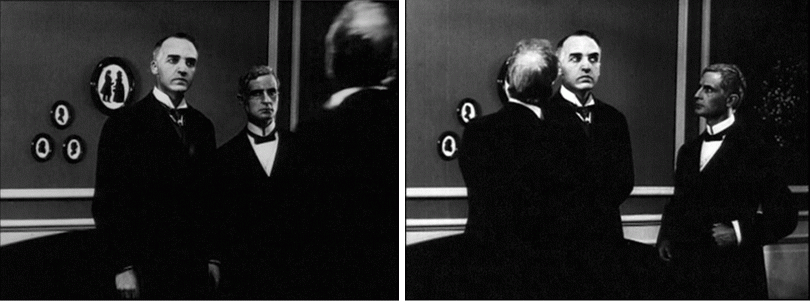
Eyeline matching
The screen direction is matched smoothly; what is a little disconcerting by modern standards is the eyeline match just before that, with the men looking off left and Werner looking off left as well. Eyeline matching was quite loose in this period, in America as well as Europe; the presumption seems to have been that the shared look was enough to confirm that the characters are in adjacent spaces. Such mismatched eyelines would be common in later Dreyer films, particularly La Passion de Jeanne d’Arc, and there they serve to create a mobile, unpredictable playing space. Like many European directors, Dreyer clung to ambivalent eyelines long after Americans had decided that they were misleading, but he used them creatively. Here, the purpose is more mundane, allowing Dreyer to open up the parlor and activate a new zone of space: in the shot of Werner, the two men are presumed to be “behind” the camera.
Exits and entrances
This sense of the camera as in the middle of the dramatic space is accentuated by the angle of Werner’s movements. Dreyer has his character enter the shot not perpendicularly to the camera, as if he or she was on stage, but along a diagonal, as it were brushing past the camera. A later scene in the same locale exploits this surround strategy a little more fully. By now, Dreyer has established American-style cutting patterns as the film’s internal norm. So the scene following Victorine’s sentencing begins merely with a medium-shot of Berger entering the parlor. He goes out screen right but instead of entering screen left, he comes in to Karl Victor from the right. During the cut, so to speak, his movement changes direction.

After their conversation, Karl Victor goes to the bell-pull (exit right, enter left) to summon his servant Franz. He returns (exit left, enter right) to a new view of Berger, and there he orders Franz to get the key to the passageway. Franz does so, in a passage of orthodox direction matching. But as Karl Victor takes the key, we get a fresh angle on him and Berger. Karl Victor starts out right—again, diagonally, brushing past the camera. As Berger follows, we get a new view of the doorway. The men enter diagonally from the left, in a cut that implies that they have gone around behind us.
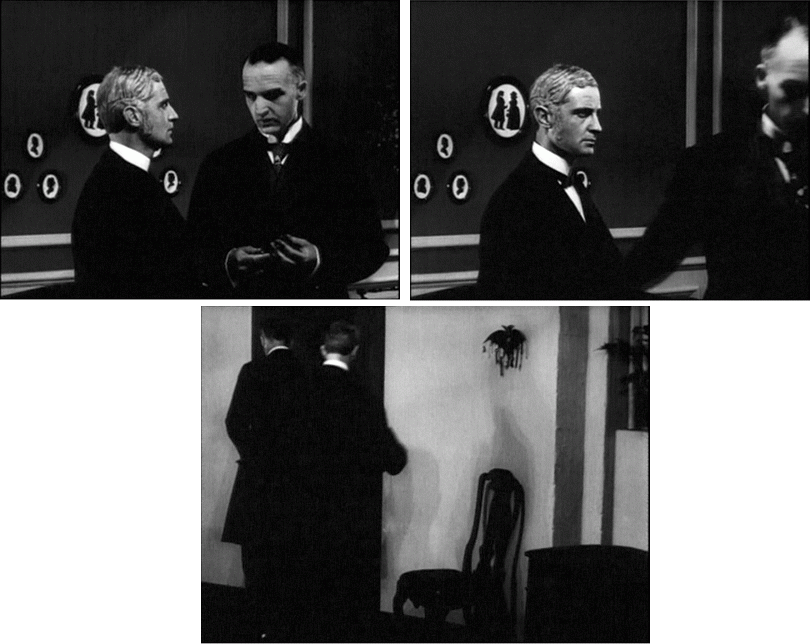
Again Dreyer has briefly put his camera at the center of the dramatic space, letting the action flow around it.
These are minor moments compared to the other sorts of cutting on display, but they seem to me not quite accidental. Deliberately or not, these roundabout figure movements, one of them violating eyeline direction, the other breaking the simple trajectory of matching screen direction across cuts, point forward to the voluminous playing spaces that Dreyer will mount later. In Vampyr and Ordet, reframings will sometimes allow characters to pass around behind the camera; someone leaves on one side of the frame and enters from the other side.11 These later films make offscreen space plastic, expanded or contracted as necessary for the rhythm of the unfolding scene. Ironically, the disorientations we find in the later films may have their sources in Dreyer’s early explorations of continuity editing, a system devised by Hollywood as guaranteeing a stable narrative space.
One of the strongest works of the era
Within Dreyer’s career, The President is usually regarded as a second-tier work—interesting and distinctive, but not up to the level of his greatest films. And it has its faults, especially some unevenness in the performances and a distracting amount of heavy make-up on its men. Yet seen in the context of European filmmaking of that moment, it strikes me as one of the strongest and most imaginative works of the era.
It is more than just a harbinger of what was to come. In a few years other Danish directors would adapt to the new technique, building their films out of hundreds of brief shots at varying distances, and if The President were simply the first among many, it would have minor interest. But Dreyer’s early mastery of American continuity is accompanied by an exploratory attitude that would push much further in the decade that followed. In his silent films Dreyer tried several editing experiments. Casper Tybjerg has offered strong evidence that Master of the House may be the fastest-cut Danish silent film,12 and La Passion de Jeanne d’Arc became a reference point for European montage.
Treating The President as a counterfoil to the tableau tradition of the 1910s also illuminates the final phase of Dreyer’s career. By the time he made Gertrud (1964), nearly all his contemporaries had left the field through death or retirement, and their final films seemed out of step. Gance’s Cyrano et D’Artagnan (1964), severely cut by its distributor, tried to recapture the picaresque fantasies of the 1920s. Ford’s Seven Women (1966) looked old-fashioned in the era of Lean and Leone, while Chaplin’s A Countess from Hong Kong (1967) seemed positively anachronistic. (The New York Times called it “a numbingly archaic farce.”13) None of these masters’ adherence to tradition exhibited the daring that Dreyer brought to his last project.
The daring Dreyer
He had already altered his style in response to sound cinema, embracing long takes and solemn camera movement, but this modern-looking tendency, prevalent in post-World War II European cinema, may have led him back to his formative years. For Gertrud can be considered a return to tableau principles, albeit on a heightened level. The lengthy, static compositions; the posed and deliberate performances; the precise choreography of figures drifting through bourgeois interiors; even the axial cutting and the absence of reverse angles: all these creative choices now seem to me an effort to reinvigorate the tradition that reigned when Dreyer began his career. But that tradition is modernized, functioning as an oblique response to the work of Antonioni and the New Wave. In a sense, Gertrud becomes the ultimate tableau film, only possible after nearly fifty years of film history had passed.
In the 1910s the stubborn young man was stirred, like his contemporaries, by the powers of continuity editing. He then worked his way through that style before in his middle age trying something closer to a “theatricalization” of cinema in Day of Wrath (1943), Two People (1945), and Ordet (1955). At the end of his life he seems to have looked back beyond American technique to discover, as he never could in his apprentice days, what could be done with the older tradition he had renounced. Like elders in any generation, he had not lost his fascination with what he had known in his youth. Unlike most, he returned to that era with deepened artistic understanding.
Notes
I’m grateful to Dan Nissen for soliciting this essay, to Thomas Christensen for assisting my research at the Danish Film Institute / Archive and Cinematheque, and to Mikael Braae for his help as well.
1. For further evidence, see my blog entry, “The magic number 30, give or take 4,” at http://www.davidbordwell.net/blog/?p=1300.
2. Jinhee Choi, The South Korean Film Renaissance: Local Hitmakers, GlobalProvocateurs (Middleton, CT: Wesleyan University Press, 2010), 4-6.
3. See Kristin Thompson, Herr Lubitsch Goes to Hollywood: German and American Film after World War I (Amsterdam: Amsterdam University Press, 2005), 18-19.
4. I survey some instances in “Nordisk and the Tableau Aesthetic,” in 100 Years of Nordisk Film, ed. Lisbeth Richter Larsen and Dan Nissen (Copenhagen: Danish Film Institute, 2006), 81-95. I discuss Afgrunden’s staging in On the History of Film Style (Cambridge: Harvard University Press, 1997), 175-178. On Danish innovations in lighting see Ron Mottram, The Danish Cinema before Dreyer (Metuchen, NJ: Scarecrow Press, 1988) and Barry Salt, Film Style and Technology: History and Analysis, 3d ed. (London: Starword, 2009), 73-84, 125-134.
5. See Kristin Thompson, Exporting Entertainment: America in the World Film Market 1907-1934 (London: British Film Insitute, 1985), 84-85.
6. On the exodus of Nordisk top-line personnel and the company’s business decisions, see Mottram, Danish Cinema before Dreyer, 212-216, and Isak Thorsen, “The Rise and Fall of the Polar Bear,” in 100 Years of Nordisk Film, ed. Larsen and Nissen, 53-71.
7. In that year Alfred Kjerulf, who was like Dreyer a Nordisk screenwriter, debuted with a 767 meter short. Interestingly, Fritz Magnussen, eleven years Dreyer’s senior, made his debut in 1917, but his career lasted only two more years; he died in 1920. For this and other information about Danish production of the period I am indebted to Marguerite Engberg’s catalogue, Den Danske Stumfilm 1903-1930 (Copenhagen: Danish Film Museum, 1968).
8. See Kristin Thompson, Herr Lubitsch Goes to Hollywood: German and American Film after World War I (Amsterdam: Amsterdam University Press, 2005), 53-63.
9. Japanese directors experimented even more vigorously with this norm, sometimes providing only shots of the listener, thus making the dialogue title come from “offscreen.” See my Ozu and the Poetics of Cinema (Princeton, NJ: Princeton University Press, 1988), 66-67.
10. See Edvin Kau, Dreyers Filmkunst (Copenhagen: Akademisk Forlav, 1989), 22-24.
11. I discuss such moments in Vampyr and Ordet in The Films of Carl-Theodor Dreyer (Berkeley: University of California Press, 1981), 101-103, 155-157.
12. Casper Tybjerg, “Honor Thy Craft: Questions of Style in Dreyer’s Master of the House,” Aura VI, 2 (2000), 67. This essay is an exemplary study of Dreyer’s distinctive use of contemporary cutting techniques.
13. Bosley Crowther, “A Countess from Hong Kong,” New York Times (17 March 1967), accessed at http://movies.nytimes.com/movie/review?res=9401E0DA1539E53BBC4F52DFB566838C679EDE.
David Bordwell | 11 June 2010
